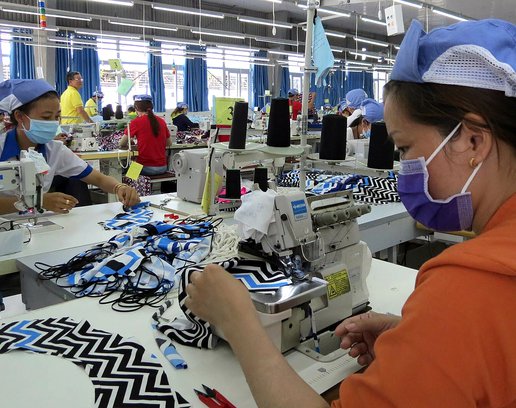Reduced shopping during the holiday season in the United States and supply chains "returning to normal" have led to overstocked American stores with worldwide implications. This is forcing suppliers in places like Vietnam to face a severe order crisis, especially in the textile, clothing, footwear and furniture sectors.
Households, retailers and charities nationwide, feeling the pinch of inflation, are bracing for a humbug holiday season.
U.S. consumers and businesses have trimmed spending plans for gifts, charitable contributions and holiday events, data show. The penny-pinching threatens to spoil the year-end for many, especially firms and nonprofits that tally their largest share of sales and donations in November and December.
Inflation has cut into America’s holiday cheer, as well as wages and gift plans.Consumer prices have risen faster than wages this year, and high inflation has proved more persistent than many policy makers expected. The high cost of living has unnerved consumers, despite a strong job market, a cushion of household savings built up during the Covid-19 pandemic and a few signs that inflation is slowing.
The University of Michigan estimated that household sentiment in the past six months is comparable to late 2008 and early 2009, when the financial system verged on economic disaster and unemployment was soaring. The index also echoes wary levels of the 1970s, when inflation climbed to double digits.
A Census Bureau survey of households in early October found that 41% of Americans, around 95 million people, said they were having difficulty paying for essential household expenses, compared with 29% a year earlier.
People plan to buy an average of nine gifts this year compared with 16 last year, according to Deloitte consulting’s 37th annual holiday shopping survey of 5,000 respondents in September. Total anticipated spending per household was $1,455, down from $1,463 a year ago, Deloitte said. People in the survey said they also planned to spend less time shopping than they did last year.
The Conference Board, a nonprofit research organization that surveys household confidence each month, said individuals had cut gift spending plans to $613 this year from $648 in 2021. Home décor, furniture, appliances, jewelry and tools are among the categories facing the biggest cuts.
In an August survey of 2,415 adults by Bankrate, the consumer finance website, 84% of holiday shoppers said they would pursue money-saving tactics this year—relying on coupons and discounts, buying fewer items, shopping for cheaper gifts and cheaper brands or making presents themselves.
Of course, the outlook might shift. Economists have found that households don’t always do what they say on survey answers. A drop in gasoline and food prices or a bump in the stock market could boost holiday spending. A recent government report showed retail sales picked up in October, in part because of higher prices.
The best news would likely be a measure of relief from inflation.
Inflation may be slowing but U.S. shoppers are watching what they spend, fearful of a coming recession. Retailers expected a bountiful sales period after more than a year of supply-chain problems. Instead, they may slash prices to get rid of excess inventory. That is forcing suppliers in places like Vietnam to face a serious crisis of orders, especially in the textile, clothing, footwear and furniture sectors.
Mid-November is usually well into the busiest time of year for Vietnam’s manufacturing sector, as holiday demand in North America and Europe drives surges in orders, and then factories churn out as much as they can before Tet.
With Tet just over two months away, this is not a normal year, thanks to the global economic situation. VnExpress ran an interesting story on companies doing everything they can to hold on to workers, such as a garment company offering employees zero-interest loans and their children scholarships.
In Binh Duong, Vietnam’s furniture production capital, some factories have already closed, with orders falling by up to 50% since the summer. The owners of some facilities that remain open, the story says, have put up their homes and cars as collateral for loans to remain open.
Recently, Ty Hung Company Ltd in Binh Tan District in Ho Chi Minh City, a company specializing in export of footwear, announced termination of contract with nearly 1,200 employees from December 1. The reason given by Ty Hung is that the import partner who is facing losses under the current economic situation will be not signing for a new order. Despite great efforts to divert the situation, the enterprise could not restore production as planned, so it is being forced to shrink its entire production base as well as a number of related units.
Mr. Nguyen Chi Trung, Chairman of the Board of Directors of Gia Dinh Group Joint Stock Company, and Vice Chairman of the Vietnam Leather, Footwear and Handbag Association, shared with Saigon Investment that the lack of orders situation for the leather and footwear industry in the last two months of the year has been extremely difficult. Orders fell by 30 percent to 40 percent, and in some factories orders fell to more than 50 percent.
The reason behind this is that the main import countries of Vietnamese leather and footwear such as the US, and the European Union, have been severely affected by inflation and also by the impact of the ongoing Russia-Ukraine conflict. This has caused consumers to tighten their spending and limit purchase of non-essential items such as leather items and footwear.
Similarly, the textiles and garments exports are also experiencing a shortage of export orders for the last months of the year. Mr. Pham Xuan Hong, Chairman of the Ho Chi Minh City Association of Garments, Textiles, Embroidery, and Knitting, said that from the third quarter on, orders began to decline sharply by 20 percent to 30 percent. In particular, large-scale enterprises, including Foreign Direct Investment (FDI) enterprises, are being strongly affected and forced to lay off workers. Small and medium-sized enterprises are cost cutting by not working overtime or reducing working hours. Many businesses are even accepting cheap orders so that they can maintain production and continue to offer jobs to their workers.
Another VnExpress story covered a South Korean garment factory that fired over 800 employees after orders collapsed. Most of those impacted are migrant workers, some of whom had only recently returned to HCMC after leaving when the lockdown ended in October 2021.
It’s tough to know how widespread such mass firings are, as they are largely reported on a one-off basis (and many probably aren’t covered at all). The official unemployment rate remains low (as always), at 2.3%, but this doesn’t include the informal sector and also doesn’t include people working reduced hours due to low demand.
This will be something to watch as the end of the year approaches, as many workers were likely expecting plenty of work - and therefore income - heading into Tet after two difficult holiday years.



